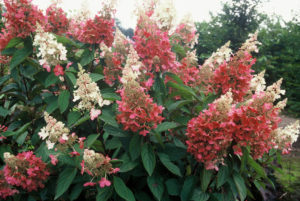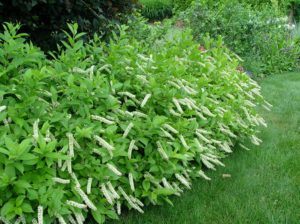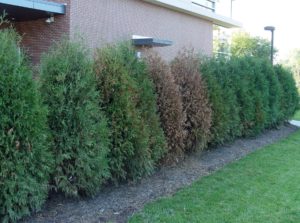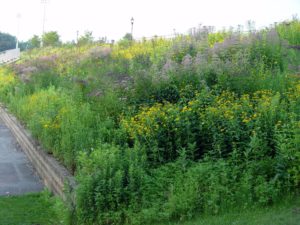Navigating the Native vs. Non-Native Controversy
June 5th, 2018
In a few more weeks, my Pinky Winky panicle hydrangea will start blooming for the 2018 season.
It’ll produce foot-long, cone-shaped flowers that start out white, then morph through a bicolor white and pink, then rosy-pink, and finally rusty/tan into winter.
It doesn’t run into any bug or disease problems, I never spray, fertilize or water it, and the only care I give it is a once-a-year cutback at the end of winter.
In short, it’s a low-care, high-output, extremely winter-hardy, impressive plant that’s one of my favorite shrubs.
Some people think I shouldn’t grow it.
That’s because this type of hydrangea is not a U.S. native species. And the extreme wing of the native-plant movement believes we should plant nothing but native plants – to the point of making people feel guilty or immoral if they plant anything else.
That point really hit home when I was helping a kindly older woman redesign her landscape. She obviously loved her plants and gardens, but when we got to her foundation planting of peonies, she asked, “Do I have to rip these out?”
“Why would you want to do that?” I replied.
“Because I heard peonies aren’t native plants and that we shouldn’t grow non-natives,” she said. “I’ll take them out if I have to, but I planted them because they were my mother’s.”
After I got over the stun, I told her that if she liked her peonies, it was perfectly fine to let them alone and enjoy them – along with the memories.
I think she was hoping that someone would bestow forgiveness for her supposed sin against nature.
At first, I thought this gardener got an erroneous, amplified version of the native message. But the more I looked, the more I found a surprising amount of talk about the “evils” of non-natives and text-yells to “GO NATIVE!”
Now, I’m all for planting more natives. They’ve been sorely under-used in our sanitized, yew-infested, lawn-dominant yards, and they’re generally good plants that are especially useful to pollinators.
But I also think it’s not as simple as all natives are good and all non-natives are bad. This isn’t an all-or-nothing issue.
Even just trying to get a handle on what’s native and what’s not is confusing.
The usual definition of “plants growing here before European settlers arrived” seems like an arbitrary line in the sand to me.
Shouldn’t it also be a no-no if native Americans had moved a plant into a new “non-native” range a hundred years before?
Why is it OK if wind or water or birds move a plant around (it’s “natural”) but not OK if white Europeans do the same?
And what if the South had won the Civil War? Would supposedly “native” Virginia sweetspires now be non-native exotics?
Just how native a plant has to be before it’s considered native is another sticking point.
Some people say the U.S. is so big and diverse that an Alaska-native heartleaf arnica or a Florida-native scrub palmetto has no value whatsoever if you’re a Pennsylvania gardener trying to GO NATIVE!
That line of thinking argues that you really have to zero in much closer on your own region. Is mid-Atlantic origin good enough for us? Or should we stick with Pennsylvania natives? Or maybe even just ones to the south-central part of the state?
If you think that’s important, by the way, Cumberland County Master Gardener Susan Skender put together a superb list that itemizes which plants are native to the six counties around Harrisburg. Not that Susan thinks that’s what we should limit ourselves to… she tackled it for educational purposes.
See Susan Skender’s list of Ultra-Local Native Plants for South-Central Pennsylvania
There’s nothing inherently or across-the-board superior about so-called native plants.
I’ve seen natives that die off, that seed around worse than weeds, and that are so rangy or bug/disease-ridden that they make terrible choices in a typical yard. After all, poison ivy is a U.S. native vine, but I wouldn’t plant that instead of an Italian clematis.
I’ve also seen non-natives – like my Pinky Winky – that are gorgeous high-performers, that are attractive to pollinators (catmint, salvia, lavender, zinnias, and Russian sage are five “exotics” that come to mind), and that aren’t invasive (the leading complaint against non-natives).
Breeders are even “cleaning up” some of the worst of the invasive non-native landscape plants by developing sterile varieties. They’ve done it with the Flutterby and Lo and Behold series of butterfly bushes and with several lines of sterile barberries that are about to debut in the next few years.
The bottom line is that I think there’s room for both natives and sensibly chosen non-natives. Rather than overly fret about where a plant originated, it makes more sense to me to evaluate each plant by its pros and cons.
Here’s what I’ve come up with while trying to make sense of it all:
* Natives are not indestructible. People seem to hear that natives have grown here for hundreds if not thousands of years, therefore they are survivors that won’t die in the garden. I wish someone would tell that to mountain laurels and inkberry hollies.
* Native or not, you still have to pay attention to where you plant what. Some natives are adapted to damp shade, others to sunny, dry meadows, still others to rocky hillsides.
If you stray too much from a plant’s preferred conditions, that native foamflower is going to croak just as fast as a Japanese azalea.
* Natives get bug damage and diseases like any other plant. In fact, some of them sustain even more bug damage than non-natives since they’re such good food for caterpillars and beneficial insects. That can be a plus, depending on your goal.
In other words, don’t expect natives to be bullet-proof perfections. They usually grow through damage, not avoid it. The last thing you want to do is spray troubled-looking natives and disrupt the very ecosystem you’re trying to help.
* Native plants do take care. Don’t expect to plant and walk away, under the belief that natives take care of themselves in nature.
You’ll still usually have to water them until the roots establish, keep them within the confines you’ve allocated for them, and do a little trimming, neatening, or “refereeing” when they’re planted in a garden setting. Think of most natives as low care, not no care.
* Be aware that native plantings can look “messy” or “weedy” to some people. That can lead to trouble when your neighbor and the code-enforcement guy see your new native meadow as a weed patch.
* Native/natural/naturalistic landscapes will bring in wildlife you may not want, i.e. groundhogs, deer, rabbits, voles, skunks, ticks, mosquitoes, snakes, etc., along with the birds, bees, butterflies, and hummingbirds you’re trying to attract.
Lawns and trimmed, sanitized landscapes are ecological wastelands, but remember, some people consider it a fair tradeoff to give up bees and butterflies to avoid ticks and mosquitoes. You might not agree, but that’s a fair opinion – especially to a family devastated by Lyme disease.
* Yes, it’s noble to want to be kind to the environment and help the struggling birds and pollinators. Most of us really need to do a better job of that. But people count, too. Why can’t we grow some plants just because we think they’re pretty, even if they have no value to a bee? Does everything in the yard have to have wildlife value or else we shouldn’t plant it?
* It makes sense that plants that are naturally adapted to a region will perform well. The problem is that most yards have been so disturbed by the removal of trees and native soil that the site you end up with bears little resemblance to its original condition.
The result is that different natives or non-natives that are adapted to your new condition probably are going to do better than what might’ve been growing there before the bulldozers showed up.
* Shrinking the lawn and replacing it with a wide diversity of plants that suit the site makes the most sense to me. In my mind, that includes both natives and non-invasive, low-input non-natives. If you plant enough good stuff, everybody will be happy.
If you’re interested in more about the native-plant “controversy,” check back next week. I’m planning to post a Patriot-News piece I wrote on a talk in which Dr. Doug Tallamy and Rick Darke made the case for more natives.
Then the week after that, I plan to post another past Patriot-News article on “Why It’s Not So Simple as Just Planting All Natives.”











